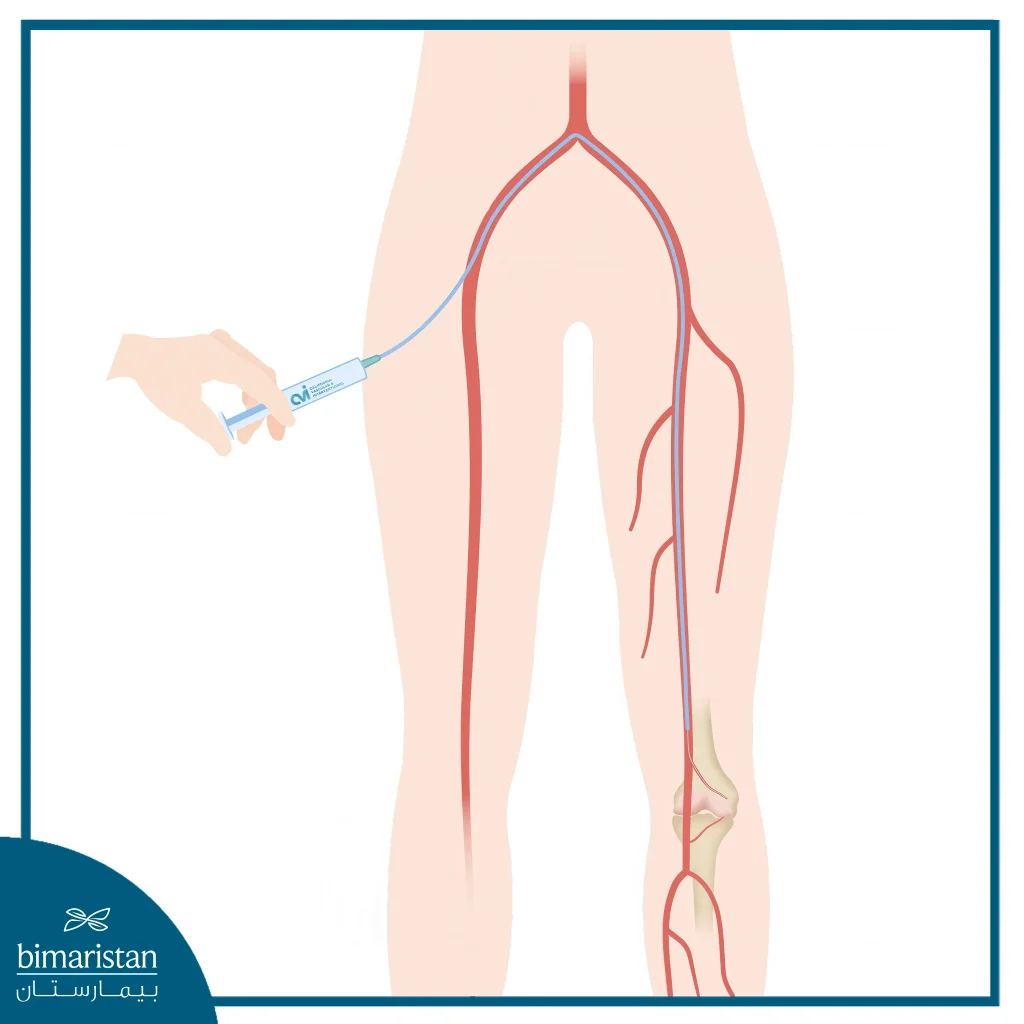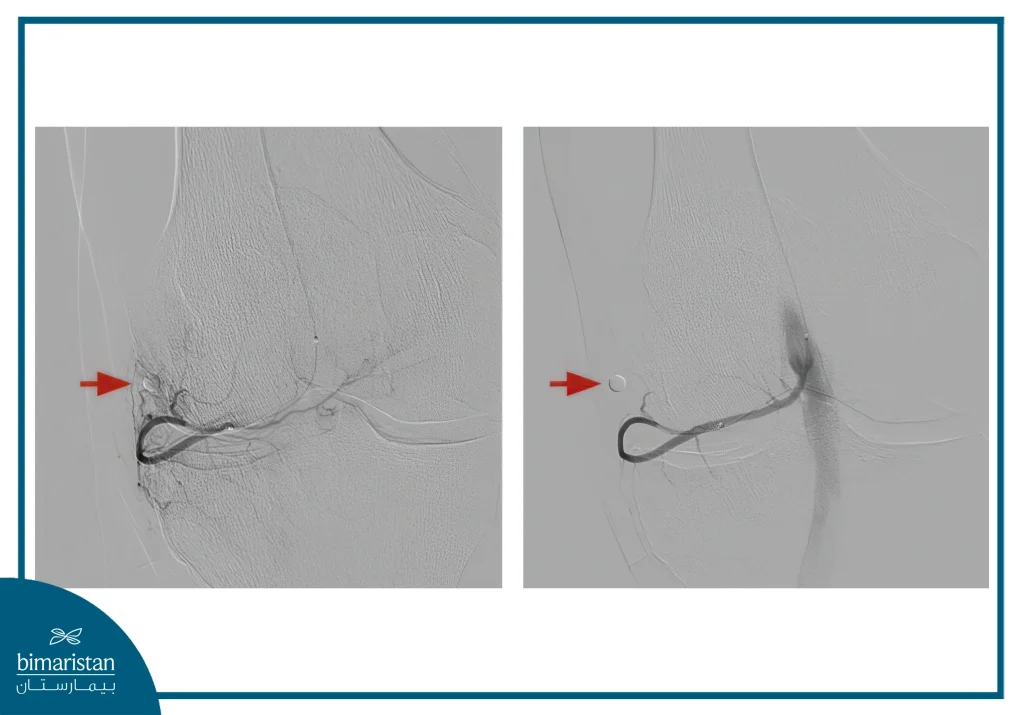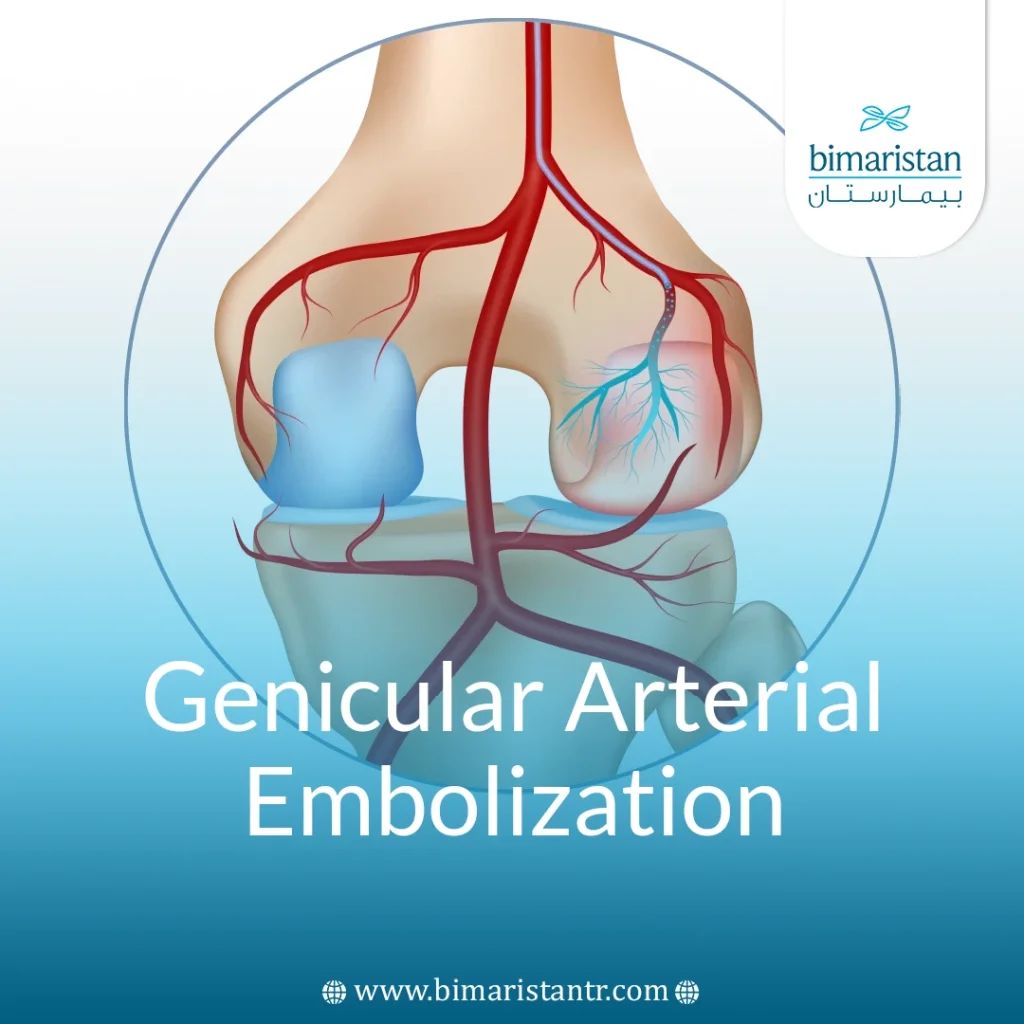Genicular arterial embolization is an interventional technique that has recently been used to treat knee pain caused by degenerative arthritis with few side effects and good success rates.
Knee pain following degenerative arthritis
Chronic knee pain following degenerative arthritis(osteoarthritis) is a major cause of mobility impairment in patients over 50 years of age, with a prevalence of about 25-30%. It requires various medical treatments, ranging from non-pharmacologic management of symptoms to total knee arthroplasty, and leads to a decrease in overall quality of life.
The initial treatment of knee pain following degenerative arthritis includes conservative measures such as physical therapy, the use of knee braces, and analgesic/anti-inflammatory medications. When the pain becomes more severe, intra-articular injections of corticosteroids and hyaluronic acid compounds are applied. If the pain is still limiting patients’ mobility despite these measures, surgical treatments, including partial and total joint replacement, may be used.
The occurrence of pain in degenerative knee arthritis results from the wear and tear of the articular cartilage, causing the femur, tibia, and patella to rub against each other; however, recent suggestions suggest that the pain is less mechanical and is often the result of chronic inflammation. Genicular arterial embolization targets the articular cartilage degeneration, which triggers a series of inflammatory reactions in the synovial tissue within the joint. These inflammatory factors cause the growth of new blood vessels and nerves within the synovial membrane, the irritation of which is ultimately the trigger that causes deep joint pain in the knee with degenerative osteoarthritis.

What is genicular arterial embolization?
Genicular arterial embolization has recently been proposed as an additional and often complementary method for the management of mild to moderate degenerative knee arthritis, and early studies have revealed promising results with only minor transient postoperative complications.
Genicular arterial embolization is not a new concept. Multiple reports on embolization to treat hemarthrosis, which commonly occurs after total knee replacement, have shown that occlusion of patellar arteries with metal particles or coils is safe and carries no risk of non-target embolization leading to distal lower extremity vascular disorder or bone infarction.
The idea that embolization of hypervascularized intra-articular synovial tissue can reduce secondary knee pain was first demonstrated by surgeon Okuno and colleagues in Japan in 2014. In a trial involving 14 patients, Genicular arterial embolization reduced pain and disability for up to 19 months after treatment. In another trial in a group of 72 patients (95 knees) treated with Genicular arterial embolization in 2017, 86% of patients reported that their pain was reduced by at least 50% months after the procedure, and the effect of Genicular arterial embolization has been shown to last for up to two years in some patients.
Another promising finding was that the majority of patients who were routinely taking strong analgesic (opioid) and non-steroidal anti-inflammatory medications before the genicular arterial embolization procedure were no longer taking them 6 months after the procedure.
Genicular arterial embolization procedure
Patient selection criteria
- Patient age ≥ 18 years
- Knee pain persisted for 6 months
- Knee pain (pain scale ≥ 4-8) occurring at least half of the days in the previous month
- Inadequate response to conservative treatment for at least 6 months
- Signs of degenerative arthritis of the knee on radiographs
Knee vascular anatomy
A basic understanding of knee anatomy is critical to safely and effectively identifying target vessels and embolization materials. In osteoarthritis of the knee, the medial aspect of the joint is affected 5–10 times more than the lateral aspect. Therefore, the branches of the medial and descending geniculate arteries are often the target vessels for Genicular arterial embolization. Genicular arterial embolization typically targets two to three hyperbranching vessels per knee due to the need to maintain some blood supply to the joint capsule.
The medial knee artery is the main feeder to the anterior and posterior cruciate ligament. In contrast, the medial and lateral patellar arteries provide blood supply to the patella and associated patellar tendon, and the cutaneous branches arising from the proximal aspect of the patellar arteries provide blood supply to the underlying knee components. These arteries are key targets for genicular arterial embolization.
Process steps
The patient’s genicular arterial embolization procedure is performed under moderate sedation in the hospital’s interventional radiology suite. The focal areas of pain identified by the patient are marked with radiographic contrast material immediately prior to the procedure, and then a local anesthetic (lidocaine 1%) is administered for femoral access.
The corresponding common femoral artery is accessed with a 21-gauge needle and then replaced with a 3F vascular catheter (in patients with high BMI, the contralateral femoral artery is accessed, and then a 6F vascular catheter is advanced over the iliac bifurcation to the common femoral artery of the target limb).
Shadow angiography of the superficial femoral and popliteal arteries is performed through a venous catheter, followed by CT of the knee to obtain a three-dimensional assessment of the perfusion of the knee arteries.
A microvascular catheter (F 1.7-2.4) is used to catheterize the targeted patellar arteries supplying the pain areas.
Genicular arterial embolization is performed with 100-mm Imposin particles until blockage occurs in the targeted distal vascular bifurcation, thereby maintaining normal blood flow within the selected artery.
After completing the embolization procedure, the vascular catheter is removed, the catheter puncture site is manually pressurized for at least 10 minutes, and the patient is immobilized for at least 3 hours.
The procedure usually takes 1-2 hours, and the patient is discharged from the hospital 4 hours after it is completed.
Materials used in the embolization procedure
A thorough understanding of each embolization agent’s properties is essential to optimizing its application. The ideal therapeutic embolization agent can be administered through any catheter tip without fear of non-targeted distal embolization.
There are two general classifications used in the treatment of degenerative knee arthritis with genicular arterial embolization: temporary embolization and permanent embolization, usually using only molecular materials to selectively embolize the vascular obstruction and the targeted pathological blood congestion area while maintaining the integrity of collateral blood perfusion from the patellar arteries to the bony and ligamentous components of the knee; this selective embolization of pathological arteries and preservation of blood flow is also essential for future interventions such as total knee replacement.

In 2013 and 2014, surgeon Okuno and colleagues achieved success using iminium and cilastatin sodium as embolization materials (IPM-CS) to treat abnormal new vessels in pathologic musculoskeletal conditions (tendinopathy, neuropathy, and adhesive capsulitis) that were resistant to conservative treatment.
Based on this success in relieving pain, Okuno first performed genicular arterial embolization for degenerative knee arthritis using IPM-CS (0.5 g of IPM-CS in 5-10 ml of iodine-labeled buffer) and used permanent resin microspheres for patients who were allergic to IPM-CS.
IPM-CS embolization material is an antibiotic crystalline mixture that has transient occlusive effects when diluted with buffer and is the most common choice for genicular arterial embolization for degenerative knee arthritis outside the United States with a particle size of ~10-70 microns. In addition to this mixture, other studies have used permanent particles in the embolization process, including Embozene microparticles (75-100 microns), Embospheres (100-300 microns), and polyvinyl alcohol (10-70 microns).
Side effects of genicular arterial embolization
Side effects and complications after genicular arterial embolization in degenerative knee arthritis are minor, transient, and mostly related to the embolization material used. The most common complication is transient cutaneous erythema, which occurs in 12% of patients. The incidence and duration of this complication were higher in permanent occlusion (63% for 1-3 months) compared to transient occlusion (2.5% for 3 weeks).
Less common complications included hematomas at the catheter insertion site (10%), plantar sensory paresthesia (1.1%), and transient mild fever (0.55%), all of which resolved within two weeks. Although the overall complications were minor and transient, there appears to be an increased incidence of complications with permanent embolization materials compared to temporary embolization materials.
Evaluating the therapeutic role of genicular arterial embolization
As knee artery embolization is being evaluated as a treatment for pain, it will be important to determine whether its therapeutic effect is greater than that of a sham treatment. Results presented at the 2020 Society of Interventional Radiology Annual Meeting showed that knee artery embolization is significantly more effective than sham angiography in reducing pain and improving function one month after the procedure.
Genicular arterial embolization is an innovative technique that is being evaluated as an additional – often complementary – method to relieve chronic pain following degenerative knee osteoarthritis. The available data indicates that genicular arterial embolization is a reasonable and safe additional option to relieve pain, reduce the use of analgesic medications and injection therapies, and improve functional status. Patients who undergo genicular arterial embolization could theoretically undergo knee replacement at an older age than others, a potentially significant benefit that requires long-term follow-up for better understanding.
Sources:
